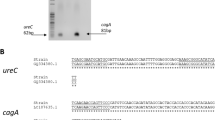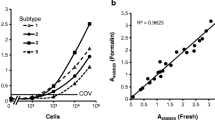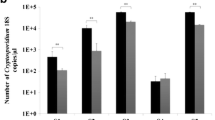Abstract
PCR and DNA sequencing are currently the diagnostic methods of choice for detection of Blastocystis spp. and their suptypes. Fresh or frozen stool samples have disadvantages in terms of several aspects such as transportation, storage, and existence of PCR inhibitors. Filter paper technology may provide a solution to these issues. The aim of the present study was to detect Blastocystis spp. and their subtypes by employing two different preservation methods: conventional frozen stool (FS) and dried stool spots on filter paper (DSSFP). Concentration and purity of DNA, sensitivity of PCR, and DNA sequencing results obtained from the two methods were also compared. A total of 230 fecal samples were included and separated into two parts: one part of the fecal samples were directly frozen and stored at −20 °C. The remaining portion of the specimens were homogenized with saline and spread onto the filter papers as thin layer with a diameter of approximately 3 cm. After air-dried, the filter papers were stored at room temperature. DSSFP samples were collected by scraping from the filter papers. DNA were extracted by EURx Stool DNA Extraction Kit from both samples. Concentration and purity were measured with Nano-Drop, then PCR and sequencing were conducted for detection of Blastocystis spp. and its genotypes. Pure DNA was obtained with a A260/A280 ratio of 1.7–2.2 in both methods. DNA yield from FS was 25–405 ng/μl and average DNA concentration was 151 ng/μl, while these were 7–339 and 122 ng/μl for DSSFP, respectively. No PCR inhibition was observed in two methods. DNA from DSSFP were found to be stable and PCR were reproducible for at least 1 year. FS-PCR- and DSSFP-PCR-positive samples were 49 (21.3 %) and 58 (25.3 %), respectively (p = 0.078). The 43 specimens were concordantly positive by both FS-PCR and DSSFP-PCR. When the microscopy was taken as the gold standard, sensitivity of DSSFP-PCR and FS-PCR was 95.5 and 86.4 %, while specificity of both tests was 99.4 and 98.3 %, respectively. DNA sequencing results of 19 microscopically confirmed cases were strictly identical (concordance 100 %) in both methods, and ST2:6, ST3:8, ST4:3, and ST6:2 were the detected subtypes. Among the 230 fecal samples, the most predominant subtypes were ST3, ST2, ST4, and ST1 by both FS and DSSFP methods. Concordance of DNA sequencing results obtained from the two methods was noted to be 90.7 %. To our knowledge, this is the first study that demonstrates DNA extraction from DSSFP is more sensitive and effective than the FS method for diagnosis of Blastocystis spp. and their subtypes by PCR and DNA sequencing.
Similar content being viewed by others
References
Abdulsalam AM, Ithoi I, Al-Mekhlafi HM, Khan AH, Ahmed A, Surin J, Mak JW (2013) Prevalence, predictors and clinical significance of Blastocystis sp. in Sebha, Libya. Parasit Vectors 6:86
Abu-Madi M, Aly M, Behnke JM, Clark CG, Balkhy H (2015) The distribution of Blastocystis subtypes in isolates from Qatar. Parasit Vectors 8:465
Boorom KF, Smith H, Nimri L, Viscogliosi E, Spanakos G, Parkar U, Li LH, Zhou XN, Ok UZ, Leelayoova S, Jones MS (2008) Oh my aching gut: irritable bowel syndrome, Blastocystis, and asymptomatic infection. Parasit Vectors 21:40
Carnevale S, Velásquez JN, Labbé JH, Chertcoff A, Cabrera MG, Rodríguez MI (2000) Diagnosis of Enterocytozoon bieneusi by PCR in stool samples eluted from filter paper disks. Clin Diagn Lab Immunol 7(3):504–506
Chen CH (2016) Development of a melting curve-based allele-specific PCR of apolipoprotein E (APOE) genotyping method for genomic DNA, Guthrie blood spot, and whole blood. PLoS One 11(4):e0153593. doi:10.1371/journal.pone.0153593
Chu DM, Sherchand J, Cross JH, Orlandi PA (2004) Detection of Cyclospora cayetanensis in animal fecal isolates from Nepal using and FTA filter-base polymerase chain reaction method. Am J Trop Med Hyg 71:373–379
Dogruman-Al DH, Yoshikawa H, Kurt O, Demirel M (2008) A possible link between subtype 2 and asymptomatic infections of Blastocystis hominis. Parasitol Res 103:685–689
Dogruman-Al F, Simsek Z, Boorom K, Ekici E, Sahin M, Tuncer C, Kustimur S, Altinbas A (2010) Comparison of methods for detection of Blastocystis infection in routinely submitted stool samples, and also in IBS/IBD patients in Ankara, Turkey. PLoS One 5(11):e15484. doi:10.1371/journal.pone.0015484
Drescher A, Graner A (2001) PCR-genotyping of barley seedlings using DNA samples from tissue prints. Plant Breed 121:228–231
Elghareeb AS, Younis MS, El Fakahany AF, Nagaty IM, Nagib MM (2015) Laboratory diagnosis of Blastocystis spp. in diarrheic patients. Trop Parasitol 5:24–29
Eroglu F, Genc A, Elgun G, Koltas İS (2009) Identification of Blastocystis hominis isolates from asymptomatic and symptomatic patients by PCR. Parasitol Res 105:1589–1592
Forsell J, Granlund M, Stensvold CR, Clark CG, Evengård B (2012) Subtype analysis of Blastocystis isolates in Swedish patients. Eur J Clin Microbiol Infect Dis 31(7):1689–1696
Harvey ML (2004) An alternative for the extraction and storage of DNA from insects in forensic entomology. J Forensic Sci 50(3):884–890
Horiki N, Maruyama M, Fujita Y, Yonekura T, Minato S, Kaneda Y (1997) Epidemiologic survey of Blastocystis hominis infection in Japan. Am J Trop Med Hyg 56(4):370–374
Karasartova D, Gureser AS, Zorlu M, Turegun-Atasoy B, Taylan-Ozkan A, Dolapci M. (2015) Blastocystosis in post-traumatic splenectomized patients. Parasitol Int. doi: 10.1016/j.parint.2015.12.004. Epub ahead of print
Leelayoova S, Taamasri P, Rangsin R, Naaglor T, Thathaisong U, Mungthin M (2002) In-vitro cultivation: a sensitive methods for detecting Blastocystis hominis. Am Trop Med Parasitol 96:803–807
Libre JM, Tor J, Manterola JM, Carbonell C, Foz M (1989) Blastocystis hominis chronic diarrhea in AİDS patients. Lancet 1:221
Lindström B, Ericsson O, Alván G, Rombo L, Ekman L, Rais M, Sjöqvist F (1985) Determination of chloroquine and its desethyl metabolite in whole blood: an application for samples collected in capillary tubes and dried on filter paper. Ther Drug Monit 7(2):207–210
Mutwewingabo A, Bogaerts J, Lemmens P, Vandepitte J (1984) Dried filter paper for sending dysenteric faeces to the laboratory. A neglected method? Ann Soc Belg Med Trop 64(1):51–55
Nadkarni MA, Martin FE, Hunter N, Jacques NA (2009) Methods for optimizing DNA extraction before quantifying oral bacterial numbers by real-time PCR FEMS. Microbiol Lett 296(1):45–51
Nantavisai K, Mungthin M, Tan-ariyaP RR, NaaglorT LS (2007) Evaluation of the sensitivities of DNA extraction and PCR methods for detection of Giardia duodenalis in stool specimens. J Clin Microbiol 45(2):581–583
Nithyamathi K, Chandramathi S, Kumar S (2016) Predominance of Blastocystis sp. infection among school children in Peninsular Malaysia. PLoS One 11(2):e0136709. doi:10.1371/journal.pone.0136709
Nuchprayoon S, Saksirisampant W, Jaijakul S, Nuchprayoon I (2007) Flinders technology associates (FTA) filter paper-based DNA extraction with polymerase chain reaction (PCR) for detection of Pneumocystis jirovecii from respiratory specimens of immunocompromised patients. J Clin Lab Anal 21(6):382–386
Ok UZ, Korkmaz M, Ok GE, Taylan Ozkan A, Unsal A, Ozcel MA (1996) Cryptosporidiosis ve blastocystosis in chronic renal failure [article in Turkish]. Türk Parazitol Derg 1(20):41–46
Osman M, El Safadi D, Cian A, Benamrouz S, Nourrisson C, Poirier P, Pereira B, Razakandrainibe R, Pinon A, Lambert C, Wawrzyniak I, Dabboussi F, Delbac F, Favennec L, Hamze M, Viscogliosi E, Certad G (2016) Prevalence and risk factors for intestinal protozoan infections with Cryptosporidium, Giardia, Blastocystis and Dientamoeba among schoolchildren in Tripoli, Lebanon. PLoS Negl Trop Dis 10(3):e0004496. doi:10.1371/journal.pntd.0004496
Parkar U, Traub RJ, Vitali S, Elliot A, Levecke B, Robertson I, Geurden T, Steele J, Drake B, Thompson RC (2010) Molecular characterization of Blastocystis isolates from zoo animals and their animal-keepers. Vet Parasitol 169:8–17
Picard-Meyer E, Barrat J, Cliquet F (2007) Use of filter paper (FTA) technology for sampling, recovery and molecular characterisation of rabies viruses. J Virol Methods 140(1-2):174–182
Poirier P, Wawrzyniak I, Albert A, El Alaoui H, Delbac F, Livrelli V (2011) Development and evaluation of a real-time PCR assay for detection and quantification of Blastocystis parasites in human stool samples: prospective study of patients with hematological malignancies. J Clin Microbiol 49:975–983
Rajendram D, Ayenza R, Holder FM, Moran B, Long T, Shah HN (2006) Long-term storage and safe retrieval of DNA from microorganisms for molecular analysis using FTA matrix cards. J Microbiol Methods 67(3):582–592
Roberts T, Barratt J, Harkness J, Ellis J, Stark D (2011) Comparison of microscopy, culture, and conventional polymerase chain reaction for detection of Blastocystis sp. in clinical stool samples. Am J Trop Med Hyg 84(2):308–312
Salvadore JM, De Ungria MC (2003) Isolation of DNA from saliva of betel quid chewers using treated cards. J Forensic Sci 48(4):794–797
Schrader C, Schielke A, Ellerbroek L, Johne R (2012) PCR inhibitors—occurrence, properties and removal. J Appl Microbiol 113(5):1014–1026
Scicluna SM, Tawari B, Clark CG (2006) DNA barcoding of Blastocystis. Protist 157(1):77–85
Sirdah MM (2014) Superparamagnetic-bead based method: an effective DNA extraction from dried blood spots (DBS) for diagnostic PCR. J Clin Diagn Res 8(4):FC01–FC04. doi:10.7860/JCDR/2014/8171.4226
Smit PW, Elliott I, Peeling RW, Mabey D, Newton PN (2014) An overview of the clinical use of filter paper in the diagnosis of tropical diseases. Am J Trop Med Hyg 90(2):195–210
Smith LM, Burgoyne LA (2004) Collecting, archiving and processing DNA from wildlife samples using FTA databasing paper. BMC Ecol 4:4
Stensvold R, Brilowska-Dabrowska A, Nielson HV, Arebdrup HC (2006) Detection of Blastocystis hominis in unpreserved stool specimens by using polymerase chain reaction. J Parasitol 92(5):081–1087
Stensvold CR (2013) Blastocystis: genetic diversity and molecular methods for diagnosis and epidemiology. Trop Parasitol 3(1):26–34
Stensvold CR, Suresh GK, Tan KSW, Thompson RCA, Traub RJ, Viscogliosi E, Yoshikawa H, Clark CG (2007a) Terminology for Blastocystis subtypes—a consensus. Trends Parasitol 23:93–96
Stensvold CR, Arendrup M, Jespersgaard C, Molbak K, Nielsen H (2007b) Detecting Blastocystis using parasitologic and DNA-based methods: a comparative study. Diagn Microbiol Infect Dis 59:303–307
Stensvold CR, Alfellani MA, Norskov-Lauritsen S, Prip K, Victory EL, Maddox C, Nielsen HV, Clark CG (2009) Subtype distribution of Blastocystis isolates from synanthropic and zoo animals and identification of a new subtype. Int J Parasitol 39:473–479
Stensvold CR, Christiansen DB, Olsen KE, Nielsen HV (2011) Blastocystis sp. subtype 4 is common in Danish Blastocystis-positive patients presenting with acute diarrhea. Am J Trop Med Hyg 84(6):883–585
Stensvold CR, Ahmed UN, Andersen LO, Nielsen HV (2012) Development and evaluation of a genus-specific, probe-based, internal-process-controlled real-time PCR assay for sensitive and specific detection of Blastocystis spp. J Clin Microbiol 50:1847–1851
Subrungruang I, Mungthin M, Chavalitshewinkoon-Petmitr P, Rangsin R, Naaglor T, Leelayoova S (2004) Evaluation of DNA extraction and PCR methods for detection of Enterocytozoon bienuesi in stool specimens. J Clin Microbiol 42(8):3490–3494
Tan KS (2008) New insights on classification, identification, and clinical relevance of Blastocystis spp. Clin Microbiol Rev 21:639–665
Tasova Y, Sahin B, Koltas S, Paydas S (2000) Clinical significance and frequency of Blastocystis hominis in Turkish patients with hematological malignancy. Acta Med Okayama 54(3):133–136
Thacker C, Phillips CP, Syndercombe-Court D (1999) Use of FTA cards in small volume PCR reactions. Progr in Forensic Genet 8:473–475
Wawrzyniak I, Poirier P, Viscogliosi E, Dionigia M, Texier C, Delbac F, Alaoui HE (2013) Blastocystis, an unrecognized parasite: an overview of pathogenesis and diagnosis. Ther Adv Infect Dis 1(5):167–178
Wheatley WB (1951) A rapid staining procedure for intestinal amoebae and flagellates. Am J Clin Pathol 21(10):990–991
Acknowledgments
We thank to BM Laboratory Company and Dr. Humen Cebbari for the technical support and Dr. Selma Usluca from the National Parasitology Laboratory, Turkish Public Health Agency, for providing the negative control samples.
Financial support
This study was funded by the Hitit University Scientific Research Projects with the grant number TIP19002.15.003. We would like to thank the Hitit University for providing the financial support.
Author information
Authors and Affiliations
Corresponding author
Ethics declarations
Ethics committee approval
The study was approved by the Clinical Research Ethics Board of Ankara Numune Training and Research Hospital, Turkey, No/Year: E.Kurul-E-15-446/06.04.2015.
Informed consent
Written informed consent was obtained from each patient who participated in this study.
Rights and permissions
About this article
Cite this article
Seyer, A., Karasartova, D., Ruh, E. et al. Is “dried stool spots on filter paper method (DSSFP)” more sensitive and effective for detecting Blastocystis spp. and their subtypes by PCR and sequencing?. Parasitol Res 115, 4449–4455 (2016). https://doi.org/10.1007/s00436-016-5231-y
Received:
Accepted:
Published:
Issue Date:
DOI: https://doi.org/10.1007/s00436-016-5231-y




